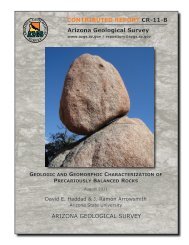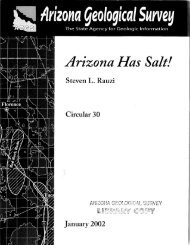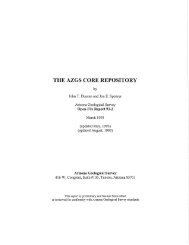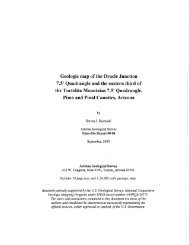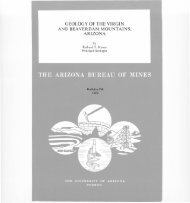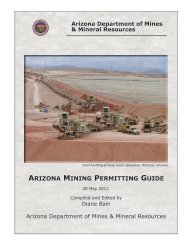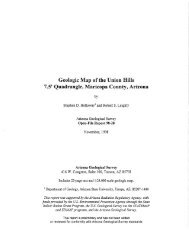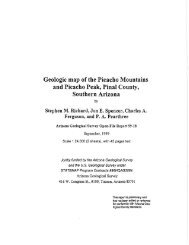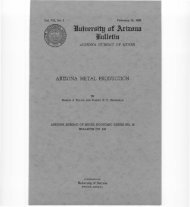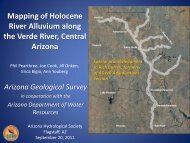Subsurface Geologic Investigation of Fountain Hills - AZGS ...
Subsurface Geologic Investigation of Fountain Hills - AZGS ...
Subsurface Geologic Investigation of Fountain Hills - AZGS ...
Create successful ePaper yourself
Turn your PDF publications into a flip-book with our unique Google optimized e-Paper software.
INTRODUCTION<br />
The Lower Verde River Valley is a discrete groundwater basin separated from the<br />
Phoenix basin by the McDowell Mountains and bounded on all sides by bedrock, (see<br />
figure 1). The basin formed during the late Miocene to Pliocene in response to crustal<br />
extension during the Basin and Range orogeny. The perennial Verde River flows<br />
southward across the valley from Bartlett Dam in the north to its confluence with the Salt<br />
River on the east side <strong>of</strong> Mount McDowell in the south. Two major ephemeral streams<br />
join the Verde River within the valley. Camp Creek drains the northwest part <strong>of</strong> the basin<br />
near Humbolt Mesa and enters the Verde River at Needle Rock. Sycamore Creek drains<br />
the northeast part <strong>of</strong> the basin, on the west side <strong>of</strong> the Mazatzal Mountains, and enters the<br />
Verde just north <strong>of</strong> Fort McDowell. Both streams typically show no surface flow except<br />
during periods <strong>of</strong> extended and heavy rainfall.<br />
The purpose <strong>of</strong> this study is to try to delineate the subsurface geology beneath the<br />
Town <strong>of</strong> <strong>Fountain</strong> <strong>Hills</strong> and the Lower Verde River Valley in order to place constraints<br />
on the shape and distribution <strong>of</strong> the groundwater reservoir(s). The surface geology was<br />
compiled mostly from recent geologic mapping by workers at the Arizona <strong>Geologic</strong>al<br />
Survey (see previous work section below) and by students from Arizona State University.<br />
The subsurface geology was interpreted from examination <strong>of</strong> over two hundred well logs<br />
obtained from the Arizona Department <strong>of</strong> Water Resources, combined with structural<br />
interpretations based on observed surface geology and geophysical data.<br />
The U.S. Army established Fort McDowell on September 7, 1865 to protect<br />
settlers against Apache Indian attacks (McDonald and Padgett, 1945). After 15 years the<br />
fort was abandoned in 1890 and established as an Indian reservation in 1891. The Fort<br />
McDowell Indian reservation is a strip <strong>of</strong> land about four miles wide and ten miles long<br />
centered on the Verde River that occupies the south-central part <strong>of</strong> the valley. East <strong>of</strong> the<br />
reservation is the Tonto National Forest. To the south is the Salt River Pima/Maricopa<br />
Indian Community. To the west is the Town <strong>of</strong> <strong>Fountain</strong> <strong>Hills</strong> and a mix <strong>of</strong> State, federal,<br />
and private land. The developments <strong>of</strong> Tonto Verde and Rio Verde have sprung up within<br />
the last ten years on the north side <strong>of</strong> the Fort McDowell Indian Reservation.<br />
<strong>Fountain</strong> <strong>Hills</strong> Blvd. provides good north-south access to the center <strong>of</strong> the valley<br />
and connects with the east-west Rio Verde Road on the north side <strong>of</strong>the valley. Rio



